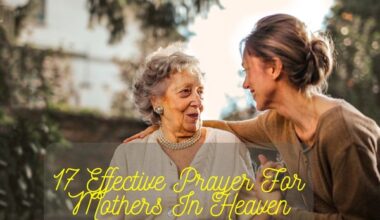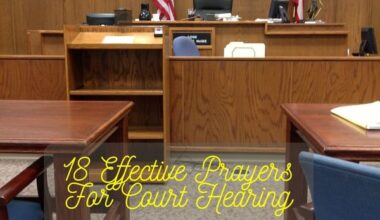Deepen Your Faith with What Does The Bible Say About Prayer Walking Discover how this simple practice can connect you with God, your community, and the world around you. Prayer walking is a spiritual practice that combines prayer with physical movement. It’s a simple yet powerful way to connect with God, engage with your community, and intercede on behalf of others.
The Bible encourages us to pray without ceasing (1 Thessalonians 5:17). We are also called to be the light of the world (Matthew 5:14) and to go into all the world and preach the gospel (Mark 16:15). Prayer walking allows us to do both of these things. We can pray for the needs of the world as we walk through it, and we can be a living witness to our faith by simply being present in our community.
The Power of Prayer
Prayer has been a cornerstone of human experience for millennia. It is a universal language, a bridge between the human and the divine, and a way to find comfort, guidance, and strength. Whether whispered in a quiet corner or shared with a community, prayer offers a space for reflection, connection, and transformation.
What Is Prayer?
Prayer is a multi-faceted act of communication with a higher power. It can take many forms, from structured rituals to spontaneous expressions of the heart. It can involve words, silence, song, music, movement, or simply an open and receptive mind. Ultimately, prayer is about connecting with something larger than ourselves, finding solace in the presence of the divine, and opening ourselves to the possibility of something beyond our understanding.
Benefits of Prayer
Research has shown that prayer has numerous benefits for both mental and physical well-being. It can:
- Reduce stress and anxiety
- Promote inner peace and calm
- Increase feelings of hope and optimism
- Boost resilience in the face of challenges
- Strengthen social bonds and community connections
- Improved sleep quality
- Lower blood pressure
- Reduce pain perception
Types of Prayer
There are countless ways to pray, and the “right” way is the one that resonates most deeply with you. Here are some common types of prayer:
- Petitionary prayer: Asking for something specific, like healing, guidance, or strength.
- Intercessory prayer: Praying for someone else or a specific situation.
- Thanksgiving prayer: Expressing gratitude for blessings received.
- Adoration prayer: Praising and worshipping the divine.
- Confession prayer: Admitting mistakes and seeking forgiveness.
- Meditation prayer: Focusing your mind and heart on the presence of the divine.
- Contemplative prayer: Reflecting on a scripture passage, a spiritual theme, or a personal experience.
- Conversational prayer: Talking to the divine as you would a friend.
How to Pray
There is no one-size-fits-all approach to prayer. Find a time and place that allows you to focus and feel comfortable. Experiment with different postures, like sitting, kneeling, or standing. You can pray aloud or silently, with words or without. Be present in the moment, open your heart, and let your thoughts and feelings flow freely.
Here are some helpful tips for getting started:
- Start small: Dedicate a few minutes each day to prayer, even if it’s just a few moments.
- Find a quiet space: Minimize distractions and create a sacred environment for prayer.
- Be authentic: Don’t be afraid to express your true feelings and emotions to the divine.
- Be patient: It may take time to develop a regular prayer practice. Don’t get discouraged if you find it difficult at first.
- Seek guidance: Talk to a spiritual leader or a trusted friend for advice on prayer.
- Explore different traditions: Learn about different prayer practices from various religions and spiritual paths.
Remember, the most important thing is to be open and sincere in your prayers. Let your heart speak, and trust that the divine hears and understands your every word, even the unspoken ones.
May your prayer journey be filled with peace, joy, and connection to the divine.
What Does the Bible Say About Prayer Walking?
While the term “prayer walking” isn’t explicitly mentioned in the Bible, the practice aligns with several biblical principles and finds support in numerous scriptural examples. Here’s a closer look:
Walking as a Spiritual Practice
- Genesis 3:8: After Adam and Eve ate the forbidden fruit, “In the cool of the evening, the Lord God walked in the Garden of Eden.” This passage sets the precedent for God’s presence being found in walking and nature.
- Joshua 1:9: “Have I not commanded you? Be strong and courageous. Do not be frightened, and do not be dismayed, for the Lord your God is with you wherever you go.” This verse reminds us that God is always with us, including when we walk and pray.
Praying without ceasing
- 1 Thessalonians 5:17: “Pray without ceasing.” This verse encourages us to constantly be in communication with God, not just in specific prayer times but throughout our daily lives. Prayer walking offers a way to integrate prayer seamlessly into our daily routines.
Examples of Prayer Walking in the Bible
- Abraham: After God promised Abraham a son, the Bible describes Abraham walking the land of Canaan (Genesis 13:17). This act can be seen as a form of prayerful exploration, claiming the land God promised him.
- Elijah: Fleeing from Queen Jezebel’s threats, Elijah walked for 40 days and nights to Mount Horeb, where he encountered God in a powerful way (1 Kings 19:4-8). This demonstrates the link between walking and seeking spiritual guidance.
- Jesus: Throughout his ministry, Jesus often walked with his disciples, teaching them and engaging in prayer (Matthew 9:35, Mark 6:6). This sets an example for us to follow in our own spiritual journeys.
Benefits of Prayer Walking
- Deepens connection with God: By combining physical movement with prayer, we can experience a deeper sense of connection with God and the world around us.
- Promotes mindfulness and focus: Focusing on our breath and surroundings during prayer walks enhances our awareness and helps us stay present in the moment.
- Offers opportunities for intercession: As we walk through our communities, we can pray for the needs of individuals and places we encounter.
- Provides physical exercise: Walking is a form of physical activity that benefits our overall health and well-being.
- Connects us with nature: Spending time in nature can be a calming and restorative experience, which can enhance our spiritual practice.
Getting Started with Prayer Walking
- Start small: Begin with short walks and gradually increase the duration as you become more comfortable.
- Choose a meaningful location: Walk in places that hold special significance for you, such as your neighborhood, a park, or a church.
- Focus on your breath and surroundings: Pay attention to your surroundings and allow them to inspire your prayers.
- Pray for individuals and places you encounter: Ask God for blessings on the people and places you see during your walk.
- Be open to God’s leading: Allow your walk to be a time of listening and receiving guidance from God.
Conclusion
Unleash the Power of Prayer Walking: Learn how combining prayer and movement can transform your spiritual life and bring blessings to your neighborhood. Prayer walking is a powerful tool that can help you deepen your relationship with God, connect with your community, and make a difference in the world.
It’s a practice that is open to everyone, regardless of age, background, or experience. So, why not take a walk and see where God leads you?
With a little practice, prayer walking can become a valuable part of your spiritual life. So, what are you waiting for? Start walking and praying today!






